

How does overfishing threaten coral reefs? Coral reef ecosystems support important commercial, recreational, and subsistence fishery resources in the U.S and its territories.
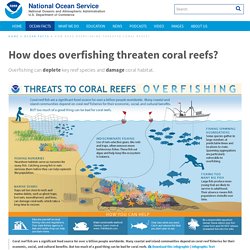
Fishing also plays a central social and cultural role in many island and coastal communities, where it is often a critical source of food and income. Corals Are Dying on the Great Barrier Reef. Scientists have discovered an unprecedented die-off in the world's largest reef, the Great Barrier Reef, prompting the Australian government to issue its highest response level.

Diver surveys based off Cape York, Australia's northeastern tip, found up to 50 percent mortality in the reef from coral bleaching. Death among the organisms that build the reef's structure is most likely linked to rising temperatures in the ocean, the government announced. "The corals in the remote far north of the reef experienced extremely hot and still conditions this summer, and were effectively bathed in warm water for months, creating heat stress that they could no longer cope with," Russell Reichelt, the chairman of the Great Barrier Reef Marine Park Authority, said in a statement.
Bleaching occurs when warm ocean water stresses corals to the point that they expel the tiny algae, known as zooxanthellae, that normally live inside their tissues. What's happening in Australia is part of a global trend. Why Are Coral Reefs So Important To The Biosphere? CORAL REEFS ARE DEFENDERS of WILDLIFE.

Coral reefs have been in the news a lot lately because they are under threat from ocean acidification, climate change (and this summer’s nasty heat wave), overfishing, coastal development, and more. Many people don’t understand why coral reefs are so important, which is why we asked an expert to help explain why coral reefs are so important and what threats they are facing. We at GreenDustries care very much about the environment. Our goal is to decries the level of garbage and pollution created by the Fast Food Industry packaging in the world, by replacing their very polluting boxes (it’s stay100’s of years in the landfills) and other form of package the burgers and fries that they are using until today, with our “ENVIRONMENT FRIENDLY “ PleatPak and Magic Bag.
Stephanie Wear is a marine scientist with The Nature Conservancy’s Global Marine Team. Coral Reef Destruction. Bleached elkhorn coral near St.
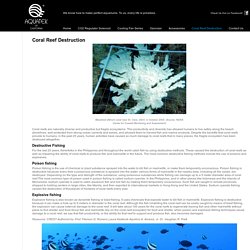
Croix, USVI, in October 2005. (Source: NOAA Center for Coastal Monitoring and Assessment) International Coral Reef Initiative. Coral reefs are often called the rainforests of the sea, both due to the vast amount of species they harbour, and to the high productivity they yield.

Aside from the hundreds of species of coral, reefs support extraordinary biodiversity and are home to a multitude of different types of fish, invertebrates and sea mammals. Covering less than one percent of the ocean floor, reefs support an estimated twenty-five percent of all marine life, with over 4,000 species of fish alone. Coral reef destruction - Simple English Wikipedia, the ... A fringing reef can take ten thousand years to form, and an atoll can take up to 30 million years[1] People look at them while snorkeling and diving.
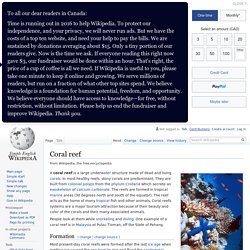
One example of a coral reef is in Malaysia at Pulau Tioman, off the State of Pahang. Formation[change | change source] Most present-day coral reefs were formed after the last ice age when melting ice caused the sea level to rise and flood the continental shelves. This means they are less than 10,000 years old. Marine Habitat Destruction. Habitat destruction occurs when the conditions necessary for plants and animals to survive are significantly compromised or eliminated.
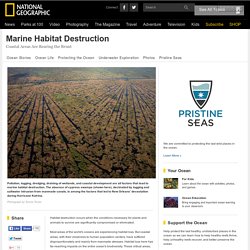
Most areas of the world's oceans are experiencing habitat loss. But coastal areas, with their closeness to human population centers, have suffered disproportionately and mainly from manmade stresses. Habitat loss here has far-reaching impacts on the entire ocean's biodiversity. These critical areas, which include estuaries, swamps, marshes, and wetlands, serve as breeding grounds or nurseries for nearly all marine species. Causes of Ocean Habitat Loss Humans and Mother Nature share blame in the destruction of ocean habitats, but not equally. 5 Causes of Coral Reef Destruction. Coral Grief: Warming Climate Threatens Reef Destruction. A survey of 704 species of coral—tiny polyps with hard shells, some of which form spectacular underwater reefs—has found that nearly 33 percent of them face a greater threat of becoming extinct as the globe warms.

The main culprits, according to the study published today in Science: bleaching—when corals expel the algae that normally feeds them and gives them color—as well as disease outbreaks in coral weakened by warming sea-surface temperatures. "If we cannot manage the [carbon dioxide] in the atmosphere, there's a very good possibility that bleaching events and disease events will be occurring with greater frequency and, if that occurs, there is a good chance that some species are not going to be able to replenish themselves fast enough," says marine biologist Kent Carpenter of Old Dominion University in Norfolk, Va., who led the research. Coral reef protection and conservation: dynamite and Cyanide fishing, pollution,, sedimentation. When people grab, kick, walk on, or collect coral, they also contribute to coral reef destruction.
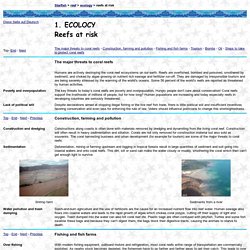
Careless boating, diving, fishing, and other recreational uses of coral reef areas can cause damage to them. On some islands the resorts use dynamite to create a passage for their boats. If here are no buoys, anchors are dropped which crush or break corals. Good meaning tourists feed reef fishes, but this results in changing their feeding behavior and don't graze on algaes anymore which can choke the corals. Polished shells, clams and Nautilus shells, jewelry made from shell or tortoiseshell, pictures with dried seahorses, ashtrays made from clams - don't buy these souvenirs!
Destruction of Coral Reefs. Destruction of the coral reefs. How do coral reefs protect lives and property? 10 Endangered Ocean Species and Marine Animals. What is Coral Bleaching, and Why Does it Occur? By Stan & Debbie Hauter Updated November 06, 2016.
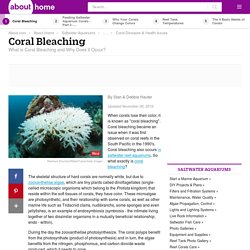
When corals lose their color, it is known as "coral bleaching". Coral bleaching became an issue when it was first observed on coral reefs in the South Pacific in the 1990's. Coral bleaching also occurs in saltwater reef aquariums. So what exactly is coral bleaching? The skeletal structure of hard corals are normally white, but due to zooxanthellae algae, which are tiny plants called dinoflagellates (single-celled microscopic organisms which belong to the Protista kingdom) that reside within the soft tissues of corals, they have color.
During the day the zooxanthellae photosynthesize. By night the polyps feed on plankton by capturing it with their tentacles. If the rate of photosynthetic production is too high, corals have the ability to control the amount of zooxanthellae in their tissues by expelling it; this is known as coral bleaching, which is normal. The effects of el Niño and la Niña events. Coral Reef Destruction Facts - The World Counts. Corals and Coral Reefs. Corals have multiple reproductive strategies – they can be male or female or both, and can reproduce either asexually or sexually. Asexual reproduction is important for increasing the size of the colony, and sexual reproduction increases genetic diversity and starts new colonies that can be far from the parents. Asexual reproduction results in polyps or colonies that are clones of each other - this can occur through either budding or fragmentation. Budding is when a coral polyp reaches a certain size and divides, producing a genetically identical new polyp.
Corals do this throughout their lifetime. Sometimes a part of a colony breaks off and forms a new colony. In sexual reproduction, eggs are fertilized by sperm, usually from another colony, and develop into a free-swimming larva. Most stony corals are broadcast spawners and fertilization occurs outside the body (external fertilization).
Coral reefs: threats. Losing Our Coral Reefs. New Guinea coral reef. Photo credit: Mbz1 at en.wikipedia. Custom Dissertation Writing Services. Coral Reef Destruction Paper instructions: • Annotated Bibliography (APSA citation format required): An annotated bibliography is a bibliography that gives a summary of each of the entries. The purpose of annotations is to provide the reader with a summary/evaluation of the source. Each summary should describe of the source’s central idea(s) and explain why this source will be useful for your research paper. This annotated bibliography must include at least 6 sources that will definitely help answer the 3 research question your paper must address.
Questionable, unauthored sources are not acceptable. The Paper Will Address 3 Basic Research Questions: (1) How serious is this problem? Destruction of Coral Reefs. Future - How can we save our dying coral reefs? I was the neoprene queen – Jacques Cousteau had nothing on me. Suckered into a tight black wetsuit, weight-belt on, the air-tank octopus grazing the back of my head, and my knees buckling under the burden of it all, I waited. Perspiration streamed down my face and prickled the back of my neck as I swayed heavily in the sweltering sun, eager to make my ungainly splash into the cool Coral Sea, off the north-east coast of Australia. Having been there two years previously, I knew what glories lay ahead in the hidden water world, where fish shimmered like jewels among gardens of coral in fantastic colours.
“The coral’s not as good this year, because of El Nino,” the dive master had warned me while we loaded up the boat. But nothing could prepare me for what I encountered on that dive. Habitat Destruction : Ocean Health Index. Habitat destruction is one of five global ecological pressures affecting the ocean, along with fishing pressure, climate change (including ocean acidification, water pollution and the introduction of alien species or genotypes. Damage or destruction of habitats kills the plants and animals responsible for the habitat's ecological functions and, in some cases, its survival and regeneration. This pressure focuses on destruction of intertidal habitats and two types of subtidal habitats, soft bottom and hard bottom. These habitats include coral reefs, sea grasses and mangrove forests, but do not include sea ice, which is accounted for elsewhere. The background photo for this page shows a coral reef at Raja Ampat, Indonesia, that was destroyed by use of dynamite for blast fishing.
Soft Bottom [Subtidal] Habitats Soft bottom environments include habitats where the seabed consists of fine grain sediments, mud and sand. Hard Bottom [Subtidal] Habitats Intertidal Habitats. Coral Reef Destruction by T B on Prezi. Conventions CoralReefs. Reefs dying faster than thought - US news - Environment ... Coral Reefs. Atmosphere Coral reefs thrive in a very narrow range of temperatures.
A sharp increase in water temperatures as seen in El Nino years can cause coral bleaching and eventual death to the coral. Top 10 Most Endangered Fish Species. "There are plenty of other fish in the sea," goes the old cliché. What’s Killing the Coral Reefs? What's Killing The Coral Reefs? What's Killing Florida's Coral Reefs? The disaster in south Florida is invisible from above water but the damage is horrific. Swimmers' Sunscreen Killing Off Coral.
The killing of coral reefs and what it means - United ... Questions by Carol Smith, Stephan Schmidt and William Auckerman. Scientists: Global warming could kill coral reefs by 2050. Why sunscreen may be killing coral reefs. For most beachgoers, sunscreen is a necessity, but a common ingredient found in many sunscreens can prove toxic to coral, a study released on Tuesday found.
Climate Change Is Killing Coral Reefs, and That Could Cost the Economy $1 Trillion a Year. At the SXSW Eco conference in Austin, Texas, this week, a frequent refrain was that humanity does not value the oceans, treating the planet’s life support system as a source of free food and, alternatively, a garbage dump for carbon dioxide, plastic, and other pollution. Well, the United Nations Convention on Biological Diversity has just put a price tag on our neglect: $1 trillion a year. Common chemical kills coral reefs. Ways to Help Coral Reefs. Sunscreen is proven toxic to coral reefs. Corals, Coral Pictures, Coral Facts. What if all the coral reefs disappeared? Scientists: To save Great Barrier Reef, kill starfish. No, your sunscreen isn't killing the world's coral reefs. Common chemical kills coral reefs. Ways to Help Coral Reefs. NOAA National Ocean Service Education: Corals. Why Coral Reefs Are Dying: Sunscreen Killing Reefs. How we are all contributing to the destruction of coral reefs: Sunscreen.
What's killing all the coral? What's Killing The Coral Reefs? The killing of coral reefs and what it means - United ... Sunscreen Could Be Killing The World's Coral Reefs, Study Says. Coral Reefs. How Sunscreen May Be Destroying Coral Reefs. What’s Killing Coral Reefs? And How Can We Stop It? Hot Oceans Are Killing Coral Reefs Around the World. What's killing all the coral? What’s Killing the Coral Reefs? What's Killing The Coral Reefs? Swimmers' Sunscreen Killing Off Coral.
Environmental issues with coral reefs - Wikipedia. Coral reef destruction. Coral reefs: threats. Coral Reefs. Dying Coral Reefs Impact Environment and Economy.